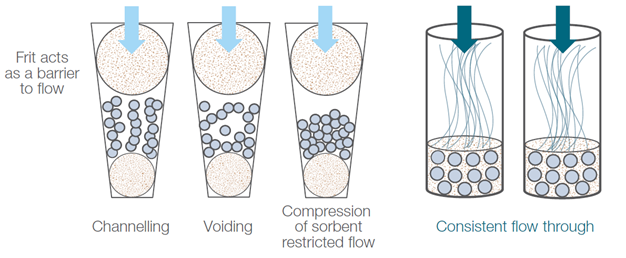Elevating Reproducibility and Recovery in Solid-Phase Extraction

Complete the form below to unlock access to ALL audio articles.
Bioanalytical and clinical research applications demand reliable results from complex samples in high-throughput environments that comply with robust legislation. When working with challenging sample matrices, such as blood, urine and tissue, success depends on achieving very clean extracts even at low detection limits, under conditions where high levels of reproducibility are essential.
Solid-phase extraction (SPE) is commonly used to purify and concentrate complex samples prior to analysis. Amenable to a broad range of biological matrices, SPE is used to separate analytes of interest from other components in complex mixtures based on a compound’s chemical and physical properties. However, despite the widespread use of the technique in bioanalytical and clinical research workflows, SPE approaches can result in consistency issues, poor recovery and insufficiently clean sample extracts. These problems may cause further challenges downstream, potentially requiring analyses to be repeated and delaying the delivery of key data.
Recent years have seen significant advances in separation science, leading to the development of novel technologies that can overcome the challenges traditionally encountered in SPE workflows. Increasingly, these innovative products are supporting the development of robust, efficient and easy-to-use SPE methods that enhance sensitivity, reproducibility and precision in bioanalysis.
Reproducibility and recovery challenges in solid-phase extraction
SPE is widely considered to be the most effective technique in bioanalysis for the isolation of analytes from complex biological matrices and plays a critical role in cleaning up biological samples for analysis by mass spectrometry. Key goals of SPE workflows are to improve analytical accuracy and precision, extend detection limits, and reduce signal suppression or enhancement from co-extracted components that can cause poor reproducibility and linearity of response (so-called matrix effects).
However, conventional SPE methods are associated with a number of limitations that impact on the quality and consistency of results. Traditional SPE approaches typically employ cartridges and well plates that are packed with a loose powder of silica or polymeric material positioned between two frits. These packed beds can be prone to settling and voiding during production and/or transport, resulting in the creation of channels or holes that can modify the cartridge’s or well plate’s performance. As a consequence, these packing inconsistencies can lead to sub-optimal analyte recovery and poor analytical reproducibility. For bioanalysis applications that demand the highest standards of sensitivity, reproducibility and precision, the issues caused by frit-based, loose-packed SPE technologies can compromise the accuracy of results and delay workflows due to sample failures and the need to repeat assays.
Fritless solid-phase extraction systems produce cleaner, more consistent extracts
Advances in solid-liquid extraction research have led to the development of a new generation of SPE technologies that, through their innovative fritless design, overcome the challenges associated with standard loose-packed systems. By combining the active media components and polyethylene support material into a solid, uniform sorbent bed, these systems eliminate packing inconsistencies to deliver stable and controllable eluent flow-through. As a consequence, fritless SPE cartridges and well plates offer enhanced recovery and reproducibility, helping to reduce matrix effects and more effectively process restricted volumes. These improvements extend beyond improved cartridge-to-cartridge or well-to-well consistency, with fritless designs offering enhanced batch-to-batch reproducibility when compared with conventional SPE products.
An additional advantage of the solid, uniform sorbent bed found in fritless SPE technologies is their enhanced resistance to blockages. This design makes the cartridges and well plates particularly well suited for processing viscous biological samples, reducing the risk of sample failures to support uninterrupted, high-throughput analysis. Fritless SPE technologies are also manufactured using methods that assure extractables from component parts are removed, eliminating the potential for leaching and ensuring cleaner sample extracts. Thanks to their robust design, these advanced SPE systems are helping bioanalysis laboratories achieve higher analysis speeds, lower solvent requirements, and reduced failure rates, while providing greater confidence in analytical results.
Innovative solid-phase extraction technologies for bioanalytical and clinical research
Recent years have seen fritless SPE technologies in both cartridge designs and 96-well plates used for method development and high-throughput applications. Modern designs now encompass an extensive range of high-quality polymeric active materials, providing analytical scientists with a variety of selectivity options that are stable over a wide range of pH conditions and do not lose sample capacity on drying. These include strong and weak cation/anion exchange and hydrophobic reversed-phase column chemistries, supporting reliable separation for a comprehensive range of acidic, basic, neutral and polar compounds.
Some fritless SPE packing sorbents offer up to three-fold more reversed-phase mass capacity than traditional silica-based media, allowing greater retention than similarly sized silica-based sorbents. This allows analysts to scale-down applications and take advantage of microelution SPE methods to process restricted sample volumes. Alternatively, for applications involving high volumes and low analyte concentrations, such as urine analysis, the higher loading capacity of fritless SPE media allows analysts to increase sample loading volumes to boost signal response and achieve more sensitive analyses. With fritless SPE technologies available in a broad variety of format options, sorbent chemistries and bed size configurations, an extensive range of bioanalytical applications can benefit from the enhanced sensitivity, reproducibility and precision these designs offer.
Greater sensitivity, reproducibility and precision in bioanalysis
Novel fritless technologies are helping to overcome the traditional challenges around recovery and reproducibility experienced with solid-phase extraction, to produce cleaner, more consistent extracts. By enhancing the ability to process restricted sample volumes and reducing the matrix effects caused by complex biological samples, these innovative technologies are improving analytical confidence, reducing sample failures and boosting operational efficiency in bioanalytical and clinical research.
Fritless microliter well plates (right) eliminate the channeling, voiding and blocking issues associated with traditional SPE technologies (left) to deliver consistent flow-through and therefore more reproducible and reliable results. Credit: Thermo Fisher Scientific.

